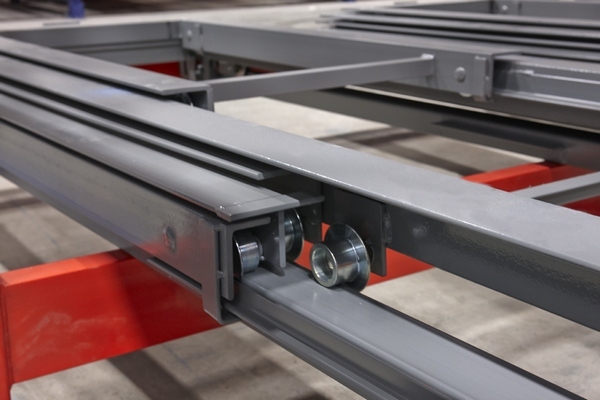Did you know pushback racking systems can double your warehouse storage capacity?
More and more warehouses are investing in pushback racking systems to maximize space, improve efficiency and maximize profits. So what is pushback racking, and what do you need to know before you invest?
What Is Pushback Racking?
Pushback racking is a high-density pallet storage system that allows you to store more pallets while maintaining easy access to each one. This system works on the principle of placing pallets on a series of carts, which are then pushed back into the system as new pallets are loaded from the front. This creates a last-in, first-out (LIFO) inventory management system, which optimizes space and improves efficiency in warehouse operations.
Download Our Guide to Learn How to Take Your Pushback Racking System From LIFO to FIFO.
Key Benefits Of Pushback Racking
Choosing pushback racking is an investment in your warehouse’s future. You can improve your inventory management, operational efficiency and reduce damage repair costs. These are the key benefits of pushback racking for warehouses:
- Increased Storage Density
- By storing pallets 2 to 6 deep, pushback racking can dramatically increase your warehouse’s storage capacity without expanding its footprint.
- Enhanced Accessibility and Selectivity
- Unlike traditional drive-in racks, pushback racking allows for accessing different SKUs from the same lane, making inventory management more flexible.
- Improved Efficiency
- Loading and unloading pallets from a single aisle reduces travel time for forklift operators, speeding up warehouse operations.
- Reduced Damage Risk
- With forklifts operating only at the racking aisle’s front, the risk of damage to the racking system is significantly minimized.
- Versatility
- Pushback racking is adaptable to a wide range of pallet sizes and weights, making it suitable for various industries, including food and beverage, retail, and manufacturing.
What to Consider Before Investing In Pushback Racking

Warehouse Layout and Space
It’s important to understand your warehouse layout and available space to decide which pushback depth is right for your warehouse. Pushback racking is so widely used because of its efficiency in terms of vertical and horizontal space utilization. Check out our technical documents to see what size is best for your warehouse needs.
FIFO or LIFO?
Pushback racking has both First-In-First-Out and Last-In-First-Out abilities; however, your warehouse will need to be designed to accommodate your chosen method of inventory management.
Learn how to achieve FIFO with Pushback Racking Systems.
Maintenance Requirements
When investing in a high-quality pushback racking system, you want it to have a long lifespan. However, it is important to find a system that requires minimal to no maintenance to keep your warehouse operations efficient. 3D Pushback Racking Systems have permanently lubricated bearings, meaning there is no required maintenance.
Why Choose 3D Storage Systems?
As leading producers of dynamic high-density storage systems in North America, we pride ourselves on our expertise, our knowledge of customer needs and the ability to service local distributors. Our turnkey pushback racking systems are engineered for durability, efficiency and warehouse maximization, ensuring an investment supports your organization’s needs as you scale.
“I just wanted to say thanks for supporting my company over these past 10 years by providing quality pushback rack, pallet flow rack, and case flow systems. Its been a pleasure working with your skilled engineering department helping us solve our customers material handling challenges. 3D has helped greatly improve our success. Thank you and we look forward to many more years working together proving great quality rack systems.”
Steve Cox, President
Cox Industrial Equipment Inc.
We offer comprehensive support, from initial design and layout optimization to installation and maintenance, making us the ideal partner for dealers and their clients. By choosing 3D Storage Systems, you’re not just investing in a pushback racking system; you’re investing in a partnership for your business success and enhancing warehouse operations.
Get in Touch
Contact 3D Storage Systems to get your Free Quote or Drawing!
Frequently Asked Questions
Do I need special forklifts?
No. 3D’s Pushback Racks are compatible with a variety of forklifts typically used in warehouses, including Counterbalance, Reach, Deep Reach, Swing Reach and Clamp Trucks.
How much push is required by the forklift?
The forklift is required to push 4% of the total weight of pallets being pushed back, not including the pallets on the forks of the truck. For example: 2,000 lbs on a six-deep would require 400 lbs of force to load. This is within the capabilities of most lift trucks or forklifts.
What size of aisle do I require?
Your aisles should be wide enough to allow an operator to square up to the pallet without turning into the rack. Usually, this requires 6” more than the truck manufacturer’s minimum aisle requirement.
What are the space requirements?
These are the general spacing requirements for pushback racking.
Vertical level to level of beams
| Pallet Depth | Height Requirements |
| For 2, 3 & 4 Deep Pushback | Pallet Height + 12” |
| For 5 & 6 Deep Pushback | Pallet Height + 14” |
Rack Depth
(# of pallets deep X (pallet depth + 2”)) + 2” = Rack Depth
For example, a 2 Pallet Deep System with a Pallet Depth of 24” would require a 102” rack depth
(2 X (48” + 2”)) + 2” = 102”
Beam Width
| Single Wide Bays | Pallet + 8” |
| Double Wide Bays | (Pallet x 2) + 16” |
How difficult is it to load and unload?
There is a very small learning curve for operators; however, most find that it is easier to load and unload than standard pallet racks. Our experience has shown that it typically takes operators half a day to become completely efficient. You will receive operating instructions with each system.
Have questions we haven’t answered? Contact us, and one of our expert team members will help.

